San Francisco Opera’s second offering of the 2017/18 season is Richard Strauss’ Elektra (1909). Conducted by Henrik Nánási, the entire experience is magnificent. Directed by Keith Warner, the one-act opera (approximately an hour and forty-five minutes) is an international co-production with San Francisco Opera, the National Theatre of Prague and the Badisches Staatstheater Karlsruhe. Set designer Boris Kudlička presents us with a gallery in a modern museum that is hosting an exhibit of ancient Greek artifacts – including the so-called Mask of Agamemnon. An aggressive visitor (Christine Goerke) manages to allude the security guards and hides herself so as to remain after closing hours. As the lights dim, she is absorbed into the fantastical situation – becoming Elektra, daughter of Agamemnon and Clytemnestra. And the fun begins. Elektra’s father has been murdered by her mother and the mother’s lover, Aegisthus. Elektra is determined to entice her brother Orest and sister Chrysothemis into killing Clytemnestra. “I’ve sung many a heroine,” said soprano Adrianne Pieczonka, “but the role of Chrysothemis stands apart.”
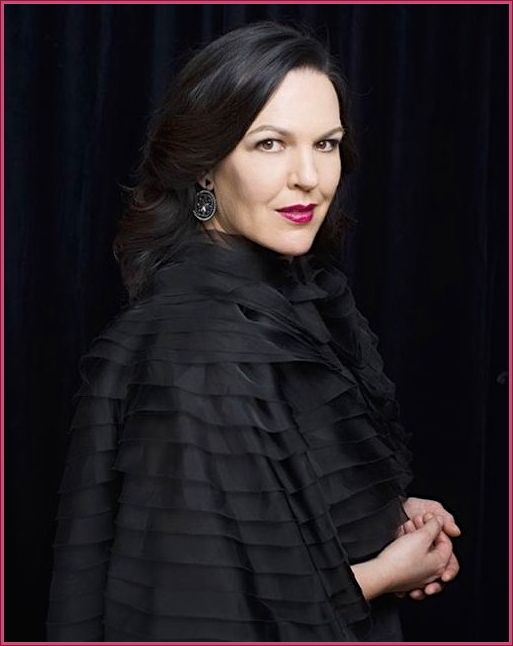
ADRIANNE PIECZONKA
“It boggles my mind that he wrote Elektra so early, because it is so far out there and modern sounding. Sitting in the audience and hearing the score today – it sounds fresh and contemporary. He wrote it way-before Der Rosenkavalier and Arabella – which are both conventional, with more pretty melodies and stuff. Elektra is a frenetic, crazy psychodrama that asks the soloists for specifics. My role sits high in the tessitura and has a lot of demands on it.”
In her five-minute aria, “Ich hab’s wie Feuer in der Brust”, Chrysothemis protests to her sister: I can’t just sit here like you, staring into the darkness! I’ve got to get away. I will not sleep here every night until Death releases me. I want to have children, even if my husband is a peasant. I am a woman and I want a woman’s life. Better to be dead than to endure this living death.
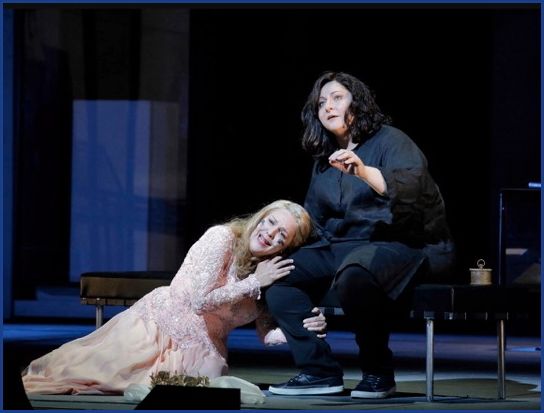
Adrianne Pieczonka (Chrysothemis) and Christine Goerke (Elektra)
“I think it’s doubly poignant in the context of the opera which is about murder and vengeance, blood and death. Death permeates the house. She has a beating heart, she wants to live. She wants to get out of there – to get out of Dodge. It’s just the same depressing thing everyday and she feels locked in. She does not want to grow old there like her sister – who is in her own prison of vengeance – and under the weight of what has happened in the trauma this family has undergone. You can see this in families today – one sibling is more resilient or robust and is able to withstand and surmount the difficulties. They can get out and have a happy relationship. She wants to have a family and have babies before it’s too late. She says that it could be with a farmer, that she doesn’t care who it is. ‘I just want to get out. I want to be loved, to breast-feed, and feel that life force.’ You can hear this in the music. People have come up to me to say how moved they were by this very special moment.”
Does the role fulfill you as an actress as much as it does as a singer?
“Yes. I’m used to singing the title roles, such as Tosca. But as a supporting role, I find Chrysothemis satisfying enough. She has three big scenes. The first is her aria, describing what she wants out of life. The scene in the middle is where she finds out her brother, Orest, has been killed. The final scene is the biggest moment – it’s extremely high and extremely loud with the orchestra. She comes out and in a sort-of ecstasy says that Orest is not dead, but that he lives and they must celebrate. It’s a real highlight of the opera where she has this big duet with Elektra. It’s all cylinders firing, the orchestra soaring, the singers soaring – very big on every front, a big finish. It’s questionable what happens to her sister. It’s often interpreted that Elektra dies, that she basically burns-out and collapses. In this production, she just collapses. Chrysothemis certainly lives. But as far as her quality of life? Does she escape? Not known.”
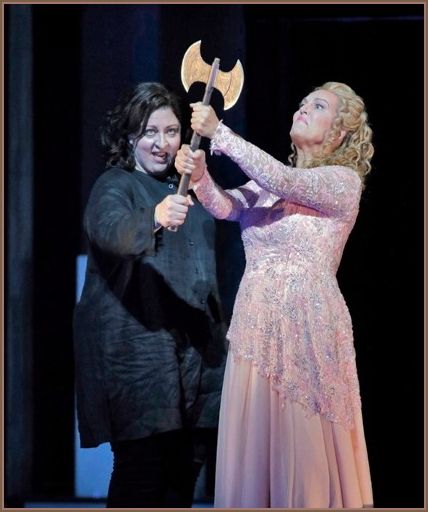
Christine Goerke and Adrianne Pieczonka in Elektra at SFOpera
“My first Strauss role was Arabella, followed by the Marschallin in Der Rosenkavalier, Ariadne, and the Kaiserin in Die Frau ohne Schatten. Then came Chrysothemis. It was a natural progression. I had a lot of success singing those roles and working with the greatest maestros around the world. My first attempt with Chrysothemis was about five years ago. The production was directed by Patrice Chéreau in Aix-en-Provence and then went on to the Met. It was filmed and is available as a DVD. It’s an iconic staging – very different than the one here at San Francisco Opera. It was a big deal and got a lot of press.”

Christine Goerke, Adrianne Pieczonka, and Alfred Walker (Orest)
Adrianne’s first appearance with SFOpera was in 2009, as Tosca. The second performance, Friday, June 5, was simulcast to AT&T Park. It was a sell-out at the War Memorial Opera House and viewed by a record attendance of 27,000 at the free simulcast. What I recall most is the sense of authority and class she brought to the role, particularly in Act II when standing up to Scarpia (Lado Ataneli).
“That’s what is so fascinating about Tosca. People often call it – as it was called back then – ‘a shabby little shocker’ and try to negate it. I’m a big Puccini fan, I love all the little angles and facets. 2009 seems a long time ago. I’ve played it quite a few times since. And I think I’ve grown – as a woman, as an artist, and as a singer. So, I continue to do it. I’m sure my performance has changed from the one you saw.” [Note: Next month, Adrianne will perform Tosca at Wiener Staatsoper; then in January/February at Royal Opera, London; and in June at Staatsoper Unter den Linden, Berlin.]
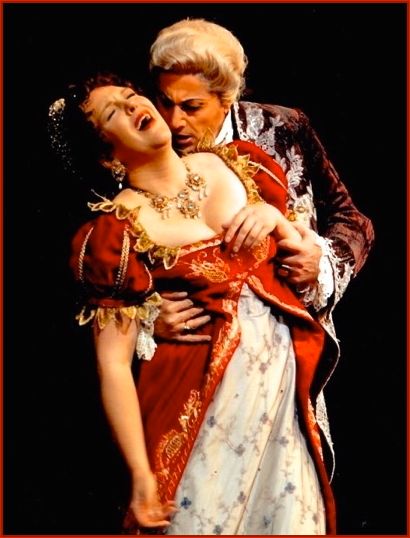
As Tosca with Lado Ataneli as Scarpia. San Fransisco Opera, June 2009
“I grew up in a family that wasn’t necessarily opera-savvy. My father was a physical engineer and my mother had aspirations as an actress. I think my drama bug came from her, but it wasn’t opera. They did like symphonic concerts and exposed us to piano lessons and ballet. I saw my first opera at fourteen, Il Trovatore, a bad one to start with – such a convoluted plot! And this was back in the days before supertitles, so God-knows-what was going on. I saw it in Hamilton, near where I grew up, with a sort-of provincial theatre company. It didn’t grab me.
“My big loves were Julie Andrews, comedians and musical theatre. I was a preteen when I wrote to Carol Burnett saying I wanted to be like her and asked what I should do. She wrote back and included a photo – telling me to keep at it and take some acting courses. I really wanted to be onstage, I didn’t know exactly how. But the piano lessons stopped. My mom asked if I’d like to take-up another instrument and I said I’d like to try voice lessons. The teacher said, ‘There is a voice in there!’ And one thing led to another. As with many people I talk to about opera, I didn’t have this thing where I became immediately obsessed. But I’ve been singing for thirty years and I’m very proud of that. In today’s opera business, thirty years is really quite extraordinary. Often you get a singer that does ten years and they’re out. Twenty – that’s it.”
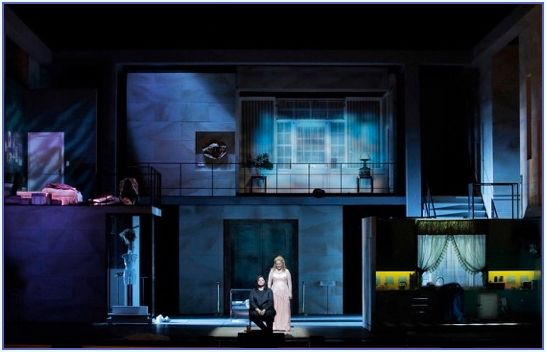
Elektra at SFOpera – Set design by Boris Kudlička
What do you do to stay in shape to sing these roles? With the kinds of political pressures and devastating climate phenomena we’ve all witnessed – let’s say, in just the past four weeks – how do you keep yourself together? Frankly, what enables you – what nurtures you – to keep on delivering what we as music lovers need in order to cope with it all?
“That’s an interesting question. We must all live with grace. These are dark, trying times and we are all sensitive beings. I do watch some news, but when I reach my fill it’s best to turn it off. I will go for a walk, do some embroidery, watch tennis. I catch the Canadian news because it keeps me connected to home. I’m interested in world news having lived in Europe for nearly twenty years. I was based in Vienna for six years and then in London. I’m a citizen of the world. We are all present – not only with the political situation, but with Hurricane Harvey and with Hurricane Irma which will hit on Saturday the night of our premiere. We’ve all been shocked and saddened. The devastation in Houston – I’ve sung in Houston (Elsa in Lohengrin) – you just have to be calm and carry on. It’s that war-time sentiment of the British which I love – the stiff upper lip. The only thing to do is to lead by example, to re-group – and tomorrow is another day. I’m walking all around the City. I’m doing Yoga on the Labyrinth at Grace Cathedral – it’s beautiful. I like to meditate. I need a lot of rest to recover between shows. I need to watch my voice. And not go to loud parties! In Richard Strauss’ song, Morgen, the first line of the text is – Und morgen wird die Sonne wieder scheinen – ‘And tomorrow the sun will rise again.’ Basically, it’s that life goes on. The song looks simple on paper. It’s not long or particularly high. However, it’s iconic – one that is so beloved by singers and one for which I have reverence and awe. I’ve done it often in a liederabend recital where I do mostly Strauss songs and will sing Morgen as an encore. You can’t do anything after that.”

ADRIANNE PIECZONKA